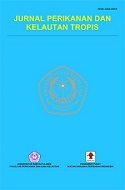Structure Of Phytoplankton Communities In Seagraas Ecosystem Of Kelurahan Tongkeina Bunaken Darat District
DOI:
https://doi.org/10.35800/jpkt.10.2.2019.24478Abstract
This research was conducted at 3 stations in the seagrass ecosystem of the Tongkeina coastal waters district of Bunaken Darat Manado on March 16, 2019, at 10:35 - 13:45 WITA. This study aims to know the types and community structures of phytoplankton in the Tongkeina seagrass ecosystem and its environmental conditions. The method used to collect the sample is sampling. Samples were taken using a plankton net measuring 20 cm in mouth diameter with a mesh size of 60 microns. Based on the results of observations obtained by the composition of phytoplankton species, namely 17 genera of 22 species in 3 classes namely Bacillariophyceae, Cyanophyceae, and Pyramimonadophyceae. The highest density of phytoplankton in Tongkeina waters is at Station 2 (0.360 cells / l) with the highest relative density of Chaetoceros sp. (19.10%). While the highest density of phytoplankton is found at Station 3 (0.516 cells / l) with the highest relative density of Melosira sp. (21.69%). The lowest Diversity Index at Station 2 (H '= 2,217) and the highest at station 3 (H' = 2,284). This shows that overall these waters have moderate diversity values. The lowest Uniformity Index at Station 1 (e = 0.858) and the highest at Station 2 (e = 0.924). This shows that overall these waters have a medium uniformity value. The lowest dominance index at Station 3 (C = 0.119) and the highest at Station 1 (C = 0.127). This shows that no species dominate the waters. The water conditions such as temperature, salinity, pH, and brightness still support the growth of phytoplankton.
Keywords: phytoplankton, community structure, seagrass, Tongkeina
Â
ABSTRAK
Penelitian ini dilakukan pada 3 stasiun di perairan ekosistem lamun kelurahan Tongkeina kecamatan Bunaken Darat pada tanggal 16 Maret 2019 pukul 10:35 – 13:45 WITA, dengan tujuan mengetahui jenis dan struktur komunitas fitoplankton yang ada di perairan ekosistem lamun Tongkeina serta kondisi lingkungannya. Metode yang digunakan adalah Metode sampling. Sampel diambil dengan menggunakan plankton net berdiameter mulut berukuran 20 cm dengan mesh size 60 mikron. Berdasarkan hasil pengamatan diperoleh komposisi jenis fitoplankton yakni 17 genus 22 spesies dalam 3 kelas yaitu Bacillariophyceae, Cyanophyceae, dan Pyramimonadophyceae.
Kepadatan tertinggi fitoplankton di perairan Tongkeina terdapat pada Stasiun 2 (0.360 sel/l) dengan kepadatan relatif tertinggi Chaetoceros sp. (19.10%). Sedangkan kepadatan fitoplankton tertinggi terdapat pada Stasiun 3 (0.516 sel/l) dengan kepadatan relatif tertinggi Melosira sp. (21.69%). Indeks Keanekaragaman terrendah pada Stasiun 2 (H’= 2.217) dan tertinggi pada stasiun 3 (H’= 2.284). Hal ini menunjukkan bahwa secara keseluruhan perairan ini memiliki nilai keanekaragaman sedang. Indeks Keseragaman terrendah pada Stasiun 1 (e= 0.858) dan tertinggi pada Stasiun 2 (e= 0.924). Hal ini menunjukkan bahwa secara keseluruhan perairan ini memiliki nilai keseragaman sedang. Indeks Dominansi terrendah pada Stasiun 3 (C= 0.119) dan yang tertinggi pada Stasiun 1 (C= 0.127). Hal ini menunjukkan bahwa tidak ada jenis yang mendominasi perairan. Adapun kondisi perairannya seperti suhu, salinitas, pH dan kecerahan masih menunjang pertumbuhan fitoplankton.
Kata Kunci :Fitoplankton, Struktur Komunitas, Lamun, Tongkeina,










